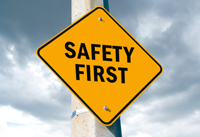Public Wi-Fi allows your team to stay connected on the go. You have to be careful, though, because public Wi-Fi is notoriously unsecure. Cybercriminals could also log into the free network you use and access data on your devices, such as your login information or confidential client files. Exercise caution and stay safe in several ways as you use your laptop, tablet or smartphone on public Wi-Fi networks.
Verify the Network Name
Before logging in, research the network. Only log into Wi-Fi that originates from a legitimate source as you avoid a man-in-the-middle attack. For example, cybercriminals may name their network “Free Wi-Fi” or mimic the establishment’s name as a way to attract users. Ask the barista, librarian or other staff member to verify the name of their public Wi-Fi network before you log in.
Turn off File Sharing
Your team relies on file sharing, but this feature is lucrative for cybercriminals, too. That’s why you want to turn off file sharing when you use public Wi-Fi. This step protects your files and data you don’t want criminals to access.
Use a VPN
A virtual private network (VPN) encrypts data as it travels between your device and the server. Research free and paid VPN options, then add one to your devices for protection when you need it on the go.
Check for HTTPS
If you see a lock symbol and HTTPS in front of the website address in the status bar, you’re browsing a secure site. You can also use an HTTPS extension for extra protection.
Enable Two-Factor Authentication
With two-factor authentication, you add an extra layer of protection to your online browsing. Even if cybercriminals gain access to your password, they probably cannot get into your account since they need to enter a unique authentication code also.
Update Software
Browser and software patches can improve security. Make it a habit to install these patches when you’re connected to a trusted network. Never update software when you’re connected to public Wi-Fi.
Forget the Network
After your public Wi-Fi session ends, log off all the websites you were signed into and tell your device to forget the network. This step prevents cybercriminals from connecting to your device automatically the next time you’re in the network area.
Limit your Activity
It’s tempting to think that cybercrime couldn’t happen to you or that you can afford to be careless because you have cybercrime and business liability insurance. However, always use caution. Save sensitive or confidential work for when you’re on a trusted network.
Your company may utilize public Wi-Fi often to stay connected and get work done. Encourage your employees to use caution and follow these steps as they stay safe.

 Before visiting a business, 90 percent of consumers read
Before visiting a business, 90 percent of consumers read  Established in 1990, the Americans With Disabilities Act (ADA) protects disabled Americans from discrimination. The term “disabled” applies to anyone with a physical or mental impairment that significantly limits or restricts a daily life activity, and ADA laws apply in the workplace and nearly any public space. Learn more about how your small business can comply with ADA laws, protect your
Established in 1990, the Americans With Disabilities Act (ADA) protects disabled Americans from discrimination. The term “disabled” applies to anyone with a physical or mental impairment that significantly limits or restricts a daily life activity, and ADA laws apply in the workplace and nearly any public space. Learn more about how your small business can comply with ADA laws, protect your  This spring, add fleet maintenance to your list of chores. The right maintenance prepares your business vehicles to operate safely during the busy spring and summer months. Plus, these tips remove remnants of winter weather and prolong the life of your valuable fleet.
This spring, add fleet maintenance to your list of chores. The right maintenance prepares your business vehicles to operate safely during the busy spring and summer months. Plus, these tips remove remnants of winter weather and prolong the life of your valuable fleet. Now that tax season has arrived, your business must address several common risks. Protect your company now and into the future when you take several steps.
Now that tax season has arrived, your business must address several common risks. Protect your company now and into the future when you take several steps.


 Federal Trade Commission and IRS agents encounter dozens of small business scams each year. Know the risks and steps you can take to protect your company in 2018.
Federal Trade Commission and IRS agents encounter dozens of small business scams each year. Know the risks and steps you can take to protect your company in 2018. We usually think of HR helping to avoid employment practice risks. We want to make sure not to be trapped in wage and hour claims, discrimination and harassment litigation, and wrongful termination lawsuits. Then there’s leave management, including ADA and FMLA. Although these are the major issues in HR risk management, HR is also instrumental in helping with other aspects of managing risk, such as:
We usually think of HR helping to avoid employment practice risks. We want to make sure not to be trapped in wage and hour claims, discrimination and harassment litigation, and wrongful termination lawsuits. Then there’s leave management, including ADA and FMLA. Although these are the major issues in HR risk management, HR is also instrumental in helping with other aspects of managing risk, such as:



